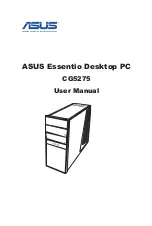
The analogue interface 7
Pin number
Signal name
Description
1
+5V
5 volt power for digital circuit
2
0V
0 volt power for digital circuit
3
0V
0 volt power for digital circuit
4
CH3
Analogue input 3
5
Analogue Gnd
0 volt for analogue circuit
6
0V
0 volt power for digital circuit
7
CH1
Analogue input 1
8
Analogue Gnd
0 volt for analogue circuit
9
Not connected
10
PB1
Pushbutton 1 (digital input)
11
VREF
Voltage reference for analogue circuit (1.8V)
12
CH2
Analogue input 2
13
PB0
Pushbutton 0 (digital input)
14
VREF
Voltage reference for analogue circuit (1.8V)
15
CH0
Analogue input 0
Choosing a games paddle
Games paddles usually consist of a small box with a single rotating knob, providing the
computer with a voltage indicating how far the knob has been rotated. A games paddle can
therefore only provide a single dimension of information to a game, such as a position in the
horizontal or vertical axis of the screen. The games paddle may also have a small pushbutton
switch or 'fire button', providing the computer with a digital 'pressed/not pressed' signal.
The games paddle should have an impedance of at least 10k ohms to match the analogue
circuitry of the Plus 1 and be wired as described above (see `Connecting to the 'analogue in'
socket').
Check the paddle for ease of use and comfort, ideally by connecting it to an Electron in the shop
and using it with the type of game or other program that you will want to use at home.
Choosing a joystick
Joysticks usually consist of a small box with a lever protruding from the top, which is free to
move up to approximately 30 degrees in any direction about a pivot at its base. This position of
the joystick lever is translated into two voltages (one for front/back, one for left/right), so that a
joystick provides two
Содержание PLUS 1
Страница 1: ......
Страница 2: ......
Страница 3: ...The Electron Plus 1 User Guide Part no 419100 Issue no 1 Date March 1984 ...
Страница 11: ...Setting up 5 ...
Страница 29: ...Notes ...
Страница 30: ......














































